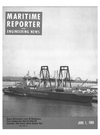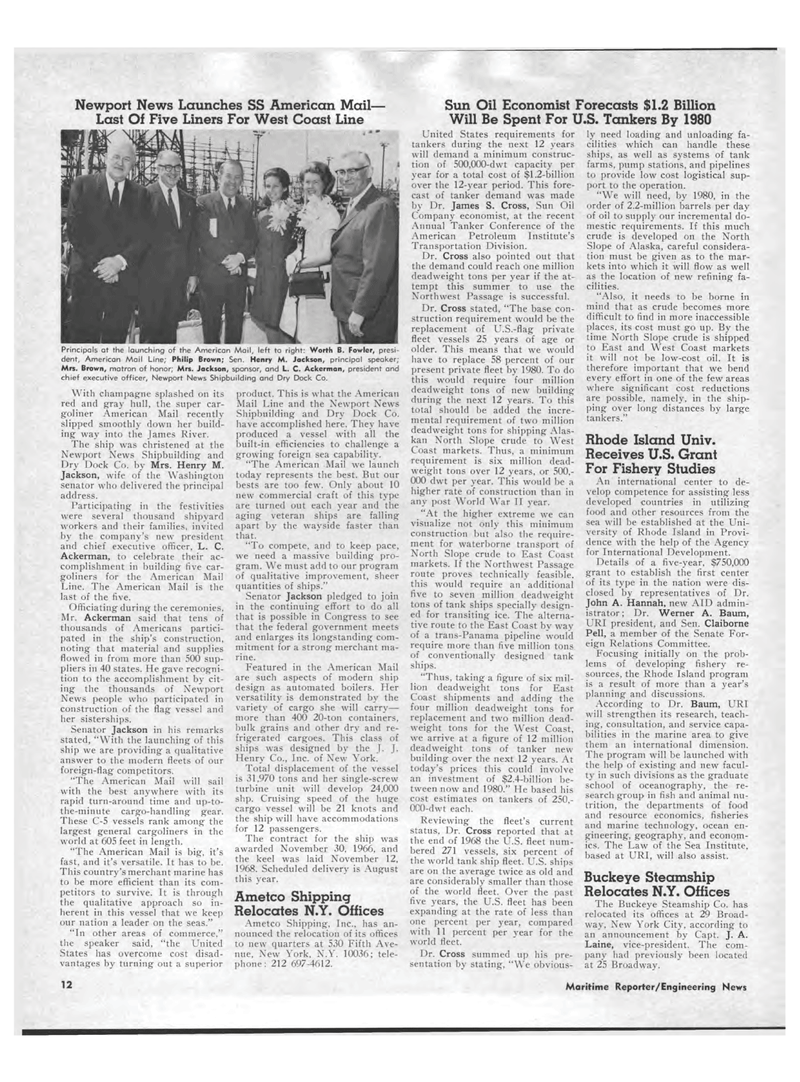
Page 10: of Marine News Magazine (June 1969)
Read this page in Pdf, Flash or Html5 edition of June 1969 Marine News Magazine
Newport News Launches SS American Mail-Last Of Five Liners For West Coast Line Sun Oil Economist Forecasts $1.2 Billion Will Be Spent For U.S. Tankers By 1980 Principals at the launching of the American Mail, left to right: Worth B. Fowler, presi-dent, American Mail Line; Philip Brown; Sen. Henry M. Jackson, principal speaker; Mrs. Brown, matron of honor; Mrs. Jackson, sponsor, and L. C. Ackerman, president and chief executive officer, Newport News Shipbuilding and Dry Dock Co. With champagne splashed on its red and gray hull, the super car-goliner American Mail recently slipped smoothly down her build-ing way into the James River. The ship was christened at the Newport News Shipbuilding and Dry Dock Co. by Mrs. Henry M. Jackson, wife of the Washington senator who delivered the principal address. Participating in the festivities were several thousand shipyard workers and their families, invited by the company's new president and chief executive officer, L. C. Ackerman, to celebrate their ac-complishment in building five car-goliners for the American Mail Line. The American Mail is the last of the five. Officiating during the ceremonies, Mr. Ackerman said that tens of thousands of Americans partici-pated in the ship's construction, noting that material and supplies flowed in from more than 500 sup-pliers in 40 states. He gave recogni-tion to the accomplishment by cit-ing the thousands of Newport News people who participated in construction of the flag vessel and her sisterships. Senator Jackson in his remarks stated, "With the launching of this ship we are providing a qualitative answer to the modern fleets of our foreign-flag competitors. "The American Mail will sail with the best anywhere with its rapid turn-around time and up-to-the-minute cargo-handling gear. These C-5 vessels rank among the largest general cargoliners in the world at 605 feet in length. "The American Mail is big, it's fast, and it's versatile. It has to be. This country's merchant marine has to be more efficient than its com-petitors to survive. It is through the qualitative approach so in-herent in this vessel that we keep our nation a leader on the seas." "In other areas of commerce," the speaker said, "the United States has overcome cost disad-vantages by turning out a superior product. This is what the American Mail Line and the Newport News Shipbuilding and Dry Dock Co. have accomplished here. They have produced a vessel with all the built-in efficiencies to challenge a growing foreign sea capability. "The American Mail we launch today represents the best. But our bests are too few. Only about 10 new commercial craft of this type are turned out each year and the aging veteran ships are falling apart by the wayside faster than that. "To compete, and to keep pace, we need a massive building pro-gram. We must add to our program of qualitative improvement, sheer quantities of ships." Senator Jackson pledged to join in the continuing effort to do all that is possible in Congress to see that the federal government meets and enlarges its longstanding com-mitment for a strong merchant ma-rine. Featured in the American Mail are such aspects of modern ship design as automated boilers. Her versatility is demonstrated by the variety of cargo she will carry? more than 400 20-ton containers, bulk grains and other dry and re-frigerated cargoes. This class of ships was designed by the J. J. Henry Co., Inc. of New York. Total displacement of the vessel is 31,970 tons and her single-screw turbine unit will develop 24,000 slip. Cruising speed of the huge cargo vessel will be 21 knots and the ship will have accommodations for 12 passengers. The contract for the ship was awarded November 30, 1966, and the keel was laid November 12, 1968. Scheduled delivery is August this year. Ametco Shipping Relocates N.Y. Offices Ametco Shipping, Inc., has an-nounced the relocation of its offices to new quarters at 530 Fifth Ave-nue, New York, N.Y. 10036; tele-phone: 212 697-4612. United States requirements for tankers during the next 12 years will demand a minimum construc-tion of 500,000-dwt capacity per year for a total cost of $1.2-billion over the 12-year period. This fore-cast of tanker demand was made by Dr. James S. Cross, Sun Oil Company economist, at the recent Annual Tanker Conference of the American Petroleum Institute's Transportation Division. Dr. Cross also pointed out that the demand could reach one million deadweight tons per year if the at-tempt this summer to use the Northwest Passage is successful. Dr. Cross stated, "The base con-struction requirement would be the replacement of U.S.-flag private fleet vessels 25 years of age or older. This means that we would have to replace 58 percent of our present private fleet by 1980. To do this would require four million deadweight tons of new building during the next 12 years. To this total should be added the incre-mental requirement of two million deadweight tons for shipping Alas-kan North Slope crude to West Coast markets. Thus, a minimum requirement is six million dead-weight tons over 12 years, or 500,-000 dwt per year. This would be a higher rate of construction than in any post World War II year. "At the higher extreme we can visualize not only this minimum construction but also the require-ment for waterborne transport of North Slope crude to East Coast markets. If the Northwest Passage route proves technically feasible, this would require an additional five to seven million deadweight tons of tank ships specially design-ed for transiting ice. The alterna-tive route to the East Coast by way of a trans-Panama pipeline would require more than five million tons of conventionally designed tank ships. "Thus, taking a figure of six mil-lion deadweight tons for East Coast shipments and adding the four million deadweight tons for replacement and two million dead-weight tons for the West Coast, we arrive at a figure of 12 million deadweight tons of tanker new building over the next 12 years. At today's prices this could involve an investment of $2.4-billion be-tween now and 1980." He based his cost estimates on tankers of 250,-OCO-dwt each. Reviewing the fleet's current status, Dr. Cross reported that at the end of 1968 the U.S. fleet num-bered 271 vessels, six percent of the world tank ship fleet. U.S. ships are on the average twice as old and are considerably smaller than those of the world fleet. Over the past five years, the U.S. fleet has been expanding at the rate of less than one percent per year, compared with 11 percent per year for the world fleet. Dr. Cross summed up his pre-sentation by stating, "We obvious-ly need loading and unloading fa-cilities which can handle these ships, as well as systems of tank farms, pump stations, and pipelines to provide low cost logistical sup-port to the operation. "We will need, by 1980, in the order of 2.2-million barrels per day of oil to supply our incremental do-mestic requirements. If this much crude is developed on the North Slope of Alaska, careful considera-tion must be given as to the mar-kets into which it will flow as well as the location of new refining fa-cilities. "Also, it needs to be borne in mind that as crude becomes more difficult to find in more inaccessible places, its cost must go up. By the time North Slope crude is shipped to East and West Coast markets it will not be low-cost oil. It is therefore important that we bend every effort in one of the few areas where significant cost reductions are possible, namely, in the ship-ping over long distances by large tankers." Rhode Island Univ. Receives U.S. Grant For Fishery Studies An international center to de-velop competence for assisting less developed countries in utilizing food and other resources from the sea will be established at the Uni-versity of Rhode Island in Provi-dence with the help of the Agency for International Development. Details of a five-year, $750,000 grant to establish the first center of its type in the nation were dis-closed by representatives of Dr. John A. Hannah, new AID admin-istrator ; Dr. Werner A. Baum, URI president, and Sen. Claiborne Pell, a member of the Senate For-eign Relations Committee. Focusing initially on the prob-lems of developing fishery re-sources, the Rhode Island program is a result of more than a year's planning and discussions. According to Dr. Baum, URI will strengthen its research, teach-ing, consultation, and service capa-bilities in the marine area to give them an international dimension. The program will be launched with the help of existing and new facul-ty in such divisions as the graduate school of oceanography, the re-search group in fish and animal nu-trition, the departments of food and resource economics, fisheries and marine technology, ocean en-gineering, geography, and econom-ics. The Law of the Sea Institute, based at URI, will also assist. Buckeye Steamship Relocates N.Y. Offices The Buckeye Steamship Co. has relocated its offices at 29 Broad-way, New York City, according to an announcement by Capt. J. A. Laine, vice-president. The com-pany had previously been located at 25 Broadway. 12 Maritime Reporter/Engineering News

 9
9

 11
11
